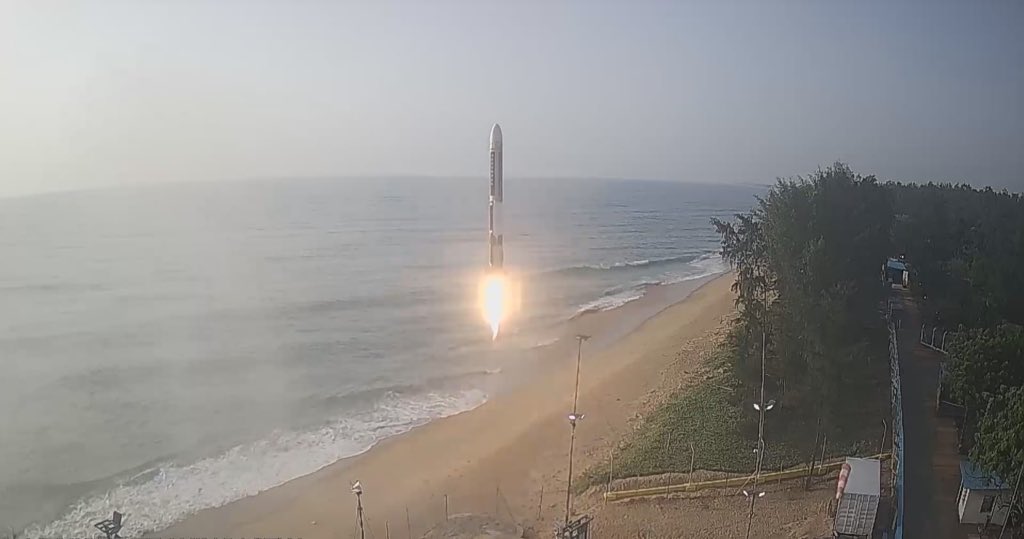India launches nation's 1st 3D-printed rocket engine
"It signals the ability to rapidly assemble rockets that is unparalleled."

Indian space startup Agnikul Cosmos successfully launched the nation's first 3D-printed rocket engine on Thursday (May 30), paving the way for reduced time and costs associated with building rockets and boosting the country's spacefaring capabilities.
"It signals the ability to rapidly assemble rockets that is unparalleled," Satyanarayanan Chakravarthy of Agnikul Cosmos, who is also a professor of aerospace engineering at the Indian Institute of Technology in Madras, said in a statement.
The maiden flight was also the country's second private rocket launch and the first to demonstrate the use of a semi-cryogenic engine. Unlike cryogenic engines that require heavy tanks to hold pressurized liquid hydrogen and oxygen at very low temperatures, semi-cryogenic engines replace the liquid hydrogen with refined kerosene. As a result, such engines require lesser storage space and normal temperatures, allowing for increased payload capacity as well as higher thrust.
Related: India makes breakthrough by test-firing new 3D-printed rocket engine (photo)
Thursday's launch of the Agnibaan Sorted (short for Suborbital Technology Demonstrator), which is designed to ferry up to 660 pounds (300 kilograms) of payload into a 435-mile (700-kilometer) orbit, was the startup's fifth attempt at the mission. Previous efforts were aborted due to technical issues, including one earlier this week that was canceled just five seconds before scheduled launch.
On Thursday, the mission lifted off from the startup's launchpad at the Satish Dhawan Space Center in Sriharikota on India's southeastern coast. The two-minute flight achieved an altitude of five miles (eight kilometers) before splashing down in the Bay of Bengal. "All the mission objectives of this controlled vertical ascent flight were met and performance was nominal," the startup said in a post on X.
"This is the culmination of 1000s of hours of reviews and hard work by the team," Srinath Ravichandran, the co-founder and CEO of Agnikul Cosmos, added in the news release. Data from this test flight will be useful to develop the startup's orbital launch vehicle, Agnibaan, perhaps by early next year.
Breaking space news, the latest updates on rocket launches, skywatching events and more!
A lot of people have been asking us, so we are posting a rough cut video for now. More videos with better views etc. will follow through the week. Mission 01 of Agnibaan SOrTeD was successfully accomplished from Agnikul Launch Pad in Sriharikota on May 30, 2024 at 0715 hours… pic.twitter.com/7G4jPN02fKJune 2, 2024
Pawan Goenka, the chairman of Indian National Space Promotion and Authorization Center (IN-SPACe), said the mission's successful launch is "a historic moment for India's space sector."
"The successful launch of the Agnibaan Sorted is not just a milestone for Agnikul Cosmos but marks a significant moment for private players who are contributing to growing India's space sector," he said in the statement. "Today it is the power of young innovators and entrepreneurs who are leading from the front, innovating with cutting-edge technology such as the world's first 3D-printed semi-cryogenic engine, that is driving the transformation of India's space sector."
The Delhi-based Indian Space Association (ISpA) said the launch will "bolster global confidence" in India's private space industry, as reported by Reuters.
Currently, Agnikul Cosmos takes about 75 hours to build one rocket engine using its automated 3D printing technology, which is much faster than the standard 10 to 12 weeks required to build a similar-sized rocket engine using conventional processes, the startup's co-founder and CEO Srinath Ravichandran told TechCrunch.
Recently, India's national space agency, the Indian Space Research Organization, or ISRO, also tested a 3D-printed rocket engine whose manufacturing reduced the number of engine parts from 14 to one, allowing the organization to save not only on raw material used per engine but also the overall production time by 60 percent.
Such leaps in homegrown technology will help India boost its launch rate as the country plans to perform up to 30 civil and commercial launches in a little over a year. The country's goals for its human spaceflight program include sending three astronauts on a three-day trip to low-Earth orbit in 2025 and to the moon by 2040, as well as establishing an orbiting space station by 2035 and a lunar base before 2050.

Sharmila Kuthunur is an independent space journalist based in Bengaluru, India. Her work has also appeared in Scientific American, Science, Astronomy and Live Science, among other publications. She holds a master's degree in journalism from Northeastern University in Boston.
